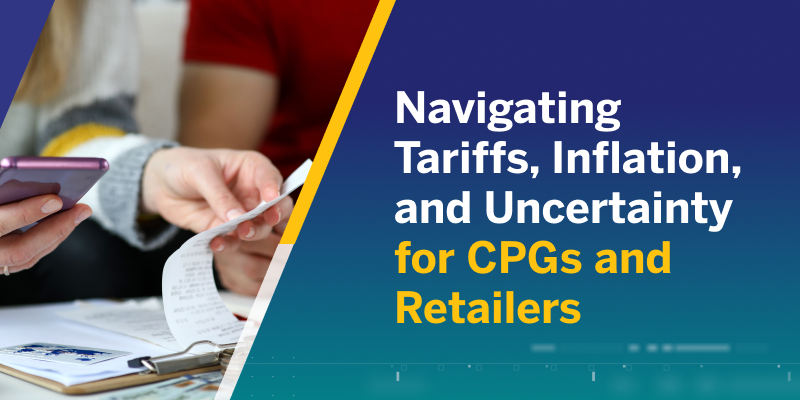
On April 2, the U.S. announced a baseline 10% tariff rate for most countries importing goods, with additional tariffs applied to select countries, bringing the total tariff rate for China to over 100%. Negotiations with some countries are already underway and, as of April 9, all reciprocal tariffs, with the exception of China, have been reduced to the 10% baseline, but ripple effects across all industries and with consumer confidence are inevitable.
Everyday staples like chocolate and coffee are among the impacted goods, with cocoa beans from Cote d'Ivoire and Ecuador now facing 10% tariffs. Outside of grocery, categories like furniture, electronics, clothes and shoes are also expected to see increases. With prices rising across the board, consumer price sensitivity and uncertainty will increase.
Threats of a trade war loom as we’re also seeing inflation crawling back up simultaneously, converging to create a precarious economic outlook. Retailers and CPGs alike have publicly spoken out about how tariffs will expectedly increase prices, preparing consumers for the sticker shock when making their everyday purchases. And while increased prices may not come as a surprise, they also present an opportunity for CPG brands and retailers to step up, reinforce trust, and deliver added value in ways that meet the needs of today’s consumers.
Between increased tariffs and inflation, economic pressure is growing.
The Reality for Consumers
Although the rate of inflation eased from 2023’s record highs, prices haven’t dropped. This past January, inflation rose 3%, with grocery prices up 1.9% and restaurant prices climbing 3.4%. February showed similar trends: grocery prices were up nearly 2% than last year and restaurant prices were up by 3.7%. In light of the most recent tariff announcement, JP Morgan raised their original prediction of a recession occurring in the next 12 months from 40% to 60%.
With new and proposed tariffs threatening to push prices even higher, shoppers brace for impact. According to January’s Inmar survey, 52% of consumers said they expected prices to rise this year. In response, many are becoming even more deliberate in their purchases, often turning to lower-cost alternatives.
- Nearly 40% reported shopping private label specifically to save money
- 78% said they’d switch brands for a better price
- 60% regularly do so based on coupons and promotions
As pressure on wallets continues to compound, consumers are actively seeking ways to stretch their budgets and reward the brands and retailers that help them spend wisely.
Delivering and Communicating Value
For today’s shoppers, delivering clear and tangible value is critical. For many shoppers, value starts with savings and if they don’t find them, they’ll switch to private label or leave the category altogether. To retain and maintain price-sensitive consumers, brands and retailers must:
- Deliver real savings through digital coupons, loyalty rewards, and targeted promotions that help shoppers stretch their budget.
- Communicate those savings clearly through media that highlights your offers, making it easy to see the value being provided.
- Reinforce value at every touchpoint through multichannel strategies that drive a consistent savings message across the shopper journey.
In the current market, where budgets are tight and loyalty is fragile, brands and retailers that deliver savings and communicate them clearly will be the ones that keep shoppers coming back.
Want to dive deeper into what today’s price-sensitive shopper expects and how you can meet their needs? Fill out the form for access to our resource, “Keys to Navigate Tariffs, Inflation, and Shopper Sensitivity,” which includes consumer insights and proven solutions that help brands and retailers deliver savings and make sure shoppers know about them.
